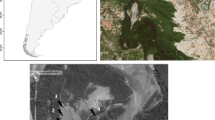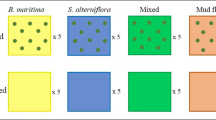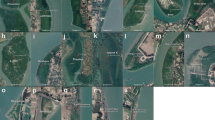Abstract
The colonization and spread of non-native species are recognized as a critical driver of environmental change in mangrove ecosystems. However, environmental factors that favor non-native plant colonization in mangroves are still poorly understood. To fill this gap, we investigated the effect of selected abiotic factors controlling non-native plant species colonization in mangroves in Southeastern Brazil. We selected 18 plots in mangrove forests under different levels of anthropogenic N inputs, both colonized and non-colonized by non-native plants in the Estuarine-Lagoon Complex of Cananeia-Iguape, southeastern Brazil. We measured interstitial salinity, sediment nitrate and ammonium concentrations, and sediment physicochemical properties. We found that interstitial salinity at 10 cm depth followed by nitrate concentrations in sediment were the main factors associated with the occurrence of non-native species in the studied mangroves. Low salinity and increased N availability in sediment allowed for the success of non-native plants into mangrove forests, also resulting in high amount of dead mangrove trunks. Aiming to conserve and restore such areas, the restoration of abiotic conditions is the first step in the management of non-native species in this region.



Similar content being viewed by others
Data Availability
The authors may provide the data used in the manuscript upon request.
References
Alongi DM (2002) Present state and future of the world’s mangrove forests. Environmental Conservation 29:331–349. https://doi.org/10.1017/S0376892902000231
Alongi DM (2014) Carbon Cycling and Storage in Mangrove Forests. Annual Review of Marine Science 6:195–219. https://doi.org/10.1146/annurev-marine-010213-135020
Alvares CA, Stape L, Sentelhas PC et al (2014) Koppen’s climate classification map for Brazil. Meteorol Zeitschrift 22:711–728. https://doi.org/10.1127/0941-2948/2013/0507
Anderson MJ (2001) A new method for non-parametric multivariate analysis of variance. Austral Ecology 26:32–46. https://doi.org/10.1111/j.1442-9993.2001.01070.pp.x
Biswas SR, Choudhury JK, Nishat A, Rahman MM (2007) Do invasive plants threaten the Sundarbans mangrove forest of Bangladesh? Forest Ecology and Management 245:1–9. https://doi.org/10.1016/j.foreco.2007.02.011
Biswas SR, Khan SI, Mallik AU (2012) Invaders’ control on post-disturbance succession in coastal mangroves. Journal of Plant Ecology 5:157–166. https://doi.org/10.1093/jpe/rtr050
Biswas SR, Biswas PL, Limon SH et al (2018) Plant invasion in mangrove forests worldwide. Forest Ecology and Management 429:480–492. https://doi.org/10.1016/j.foreco.2018.07.046
Bouyoucos GJ (1932) Studies on the dispersion procedure used in the hydrometer method for making mechanical analysis of soil. Soil Science 6:21–26
Bradley BA, Blumenthal DM, Wilcove DS, Ziska LH (2010) Predicting plant invasions in an era of global change. Trends in Ecology & Evolution 25:310–318. https://doi.org/10.1016/j.tree.2009.12.003
Cunha-Lignon M, Menghini RP (2016) Invasive species of aquatic macrophytes affecting mangrove forests structure and conservation in protected areas. Mangrove and Macrobenthos Meeting 4 Abstract Book. St. Augustine, Florida, p 85
Cunha-Lignon M, Kampel M, Menghini RP et al (2011) Mangrove Forests Submitted to Depositional Processes and Salinity Variation Investigated using satellite images and vegetation structure surveys. Journal of Coastal Research 1:344–348. https://doi.org/10.1080/01431161.2011.641511
Cunha-Lignon M, Almeida RDE, Galvani E et al (2015) Monitoramento de manguezais: abordagem integrada frente às alterações ambientais. In: Anais do VIII Congresso Brasileiro de Unidades de Conservação - Trabalhos Técnicos, pp 1–17
Dahdouh-Guebas F, Hettiarachchi S, Lo Seen D et al (2005) Transitions in ancient inland freshwater resource management in Sri Lanka affect biota and human populations in and around coastal lagoons. Current Biology 15:579–586. https://doi.org/10.1016/j.cub.2005.01.053
Donato DC, Kauffman JB, Murdiyarso D et al (2011) Mangroves among the most carbon-rich forests in the tropics. Nature Geoscience 4:293–297. https://doi.org/10.1038/ngeo1123
Dukes JS, Mooney HA (1999) Does global change increase the success of biological invaders? Trends in Ecology & Evolution 14:135–139
Embrapa (1997) Manual de Métodos de Análise de Solo, 2nd edn. rev. EMBRAPA, Rio de Janeiro
Embrapa (2009) Manual de análises químicas de solos, plantas e fertilizantes, 2nd edn. rev. EMBRAPA, Brasília
González-Muñoz N, Castro-Díez P, Parker IM (2013) Differences in nitrogen use strategies between native and exotic tree species: Predicting impacts on invaded ecosystems. Plant and Soil 363:319–329. https://doi.org/10.1007/s11104-012-1329-x
Gopal B, Chauhan M (2006) Biodiversity and its conservation in the Sundarban. Aquatic Sciences 68:338–354. https://doi.org/10.1007/s00027-006-0868-8
Greweling T, Peech M (1960) Chemical soil tests. Cornell University Agricultural Experiment Station, New York
Gufu GD, Manea A, Vorreiter L, Leishman MR (2018) Do invasive exotic and native freshwater plant species respond similarly to low additional nitrate doses? Aquatic Botany 151:1–8. https://doi.org/10.1016/j.aquabot.2018.07.007
III APG (2009) An update of the Angiosperm Phylogeny Group classification for the orders and families of flowering plants: APG III. Botanical Journal of the Linnean Society 161:105–121. https://doi.org/10.1111/j.1095-8339.2009.00996.x
Lee SY, Primavera JH, Dahdouh-guebas F et al (2014) Ecological role and services of tropical mangrove ecosystems: a reassessment. 726–743. https://doi.org/10.1111/geb.12155
Lee MR, Bernhardt ES, van Bodegom PM et al (2017) Invasive species’ leaf traits and dissimilarity from natives shape their impact on nitrogen cycling: a meta-analysis. The New Phytologist 213:128–139. https://doi.org/10.1111/nph.14115
Legendre P, Legendre L (2012) Numerical Ecology, 3rd ed. Elsevier, Amsterdam
Liao C, Peng R, Luo Y et al (2008) Altered ecosystem carbon and nitrogen cycles by plant invasion: a meta-analysis. The New Phytologist 117:706–714. https://doi.org/10.1111/j.1469-8137.2007.02290.x
Lu W, Yang S, Chen L et al (2014) Changes in carbon pool and stand structure of a native subtropical mangrove forest after inter-planting with exotic species Sonneratia apetala. PLoS One1 9:1–8. https://doi.org/10.1371/journal.pone.0091238
Lugo AE (1998) Mangrove forests: a tough system to invade but an easy one to rehabilitate. Marine Pollution Bulletin 37:427–430. https://doi.org/10.1016/S0025-326X(98)00120-9
Mack RNC, Simberloff D, Lonsdale WM et al (2000) Biotic invasions: causes, epidemiology, global consequences and control. Issues in Ecology 4:1–12. https://doi.org/10.1890/1051-0761(2000)010[0689:BICEGC]2.0.CO;2
Mahiques M, de Burone M, Figueira L et al (2009) Anthropogenic influences in a lagoonal environment: A multiproxy approach at the valo grande mouth, Cananéia-Iguape system (SE Brazil). Brazilian J Oceanogr 57:325–337. https://doi.org/10.1590/S1679-87592009000400007
Mahiques MM, Figueira RCL, Salaroli AB et al (2013) 150 years of anthropogenic metal input in a Biosphere Reserve: The case study of the Cananéia-Iguape coastal system, Southeastern Brazil. Environment and Earth Science 68:1073–1087. https://doi.org/10.1007/s12665-012-1809-6
Meier M (1991) Nitratbestimmung in Boden-Proben (N-min-Methode). LaborPraxis, Berlin
Pyšek P, Jarošík V, Hulme PE et al (2012) A global assessment of invasive plant impacts on resident species, communities and ecosystems: The interaction of impact measures, invading species’ traits and environment. Global Change Biology 18:1725–1737. https://doi.org/10.1111/j.1365-2486.2011.02636.x
R Core Team (2017) R: A Language and Environment for Statistical Computing. https://www.R-project.org/
Ramsar (2017) Environmental protection area od Cananéia-Iaguape-Peruíbe, Brazil, Created by RSIS V.16 on - 11 september 2017. Ramsar Information Sheet Brazil. https://rsis.ramsar.org/ris/2310
Reis CRG, Nardoto GB, Oliveira RS (2017) Global overview on nitrogen dynamics in mangroves and consequences of increasing nitrogen availability for these systems. Plant and Soil 410:1–19. https://doi.org/10.1007/s11104-016-3123-7
Reis CRG, Nardoto GB, Rochelle ALC et al (2017) Nitrogen dynamics in subtropical fringe and basin mangrove forests inferred from stable isotopes. Oecologia 183:841–848. https://doi.org/10.1007/s00442-016-3789-9
Reis CRG, Reed SC, Oliveira RS, Nardoto GB (2019) Isotopic evidence that nitrogen enrichment intensifies nitrogen losses to the atmosphere from subtropical mangroves. Ecosystems. https://doi.org/10.1007/s10021-018-0327-0
Ren H, Guo Q, Liu H et al (2014) Patterns of alien plant invasion across coastal bay areas in Southern China. Journal of Coastal Research 30:448–455. https://doi.org/10.2112/JCOASTRES-D-13-00096.1
Röderstein M, Hauffe T, Schnetter M-L et al (2013) Long-term vegetation changes in a tropical coastal lagoon system after interventions in the hydrological conditions. Aquatic Botany 113:19–31. https://doi.org/10.1016/j.aquabot.2013.10.008
Rovai A, Coelho-Jr C, Almeida R, Cunha-Lignon M, Menghini RP, Twilley RR, Cintrón-Molero G, Schaeffer-Novelli Y (2021) Ecosystem-level carbon stocks and sequestration rates in mangroves in the Cananéia-Iguape lagoon estuarine system, southeastern Brazil. Forest Ecology and Management :118553. https://doi.org/10.1016/j.foreco.2020.118553
Sathyanathan R, Thattai D, Selvam V (2014) The Coleroon river flow and its effect on the Pichavaram mangrove ecosystem. Journal of Coastal Conservation 18:309–322. https://doi.org/10.1007/s11852-014-0313-4
Schaeffer-Novelli Y, Cintrón G (1986) Guia para estudo de áreas de manguezal. Estrutura, função e flora
Schaeffer-Novelli Y, Mesquita H, de SL, Cintrón-Molero G (1990) The cananéia lagoon estuarine system, São Paulo, Brazil. Estuaries 13:193–203
Schaeffer-Novelli Y, Cintrón-Molero G, Soares MLG, De-Rosa T (2000) Brazilian mangroves. Aquatic Ecosystem Health and Management 3:561–570. https://doi.org/10.1080/14634980008650693
Schaeffer-Novelli Y, Vale CC, do, Cintrón G (2015) Monitoramento do ecossistema manguezal: estrutura e características funcionais. In: Books S (ed) Protocolos para o monitoramento de habitats bentônicos costeiros – Rede de Monitoramento de Habitat Bentônicos Costeiros – ReBentos. Instituto Oceanográfico da Universidade de São Paulo, São Paulo, pp 62–80
Spalding M, Kainuma M, Collins L (2010) World atlas of mangroves. Earthscan, London
Sutton MA, Mason KE, Sverdrup LJSH et al (2014) Nitrogen deposition critical loads and biodiversity. Springer, Dordrecht
Tomlinson P (1986) The botany of mangroves. Cambridge University Press, New York
Valiela I, Bowen JL, York JK (2001) Mangrove forests: one of the world’s threatened major tropical environments. BioScience 51:807. https://doi.org/10.1641/0006-3568(2001)051[0807:MFOOTW]2.0.CO;2
Van Kleunen M, Weber E, Fischer M (2010) A meta-analysis of trait differences between invasive and non-invasive plant species. Ecology Letters 13:235–245. https://doi.org/10.1111/j.1461-0248.2009.01418.x
Van Lavieren H, Spalding M, Alongi DM et al (2012) Securing the future of mangroves. United Nations University, Hamilton
Vilà M, Weiner J (2004) Are invasive plant species better competitors than native plant species? - Evidence from pair-wise experiments. Oikos 105:229–238
Vila M, Espinar JL, Hejda M et al (2011) Ecological impacts of invasive alien plants: a meta-analysis of their effects on species, communities and ecosystems. Ecology Letters 14:702–708. https://doi.org/10.1111/j.1461-0248.2011.01628.x
Vitousek PM, D’Antonio CM, Loope LL, Westbrooks R (1996) Biological invasions as global environmental change. American Scientist 84:218–228
Zhang Y, Huang G, Wang W et al (2012) Interactions between mangroves and exotic Spartina in an anthropogenically disturbed estuary in southern China. Ecology 93:588–597. https://doi.org/10.1890/11-1302.1
Acknowledgements
We would like to thank the Instituto Chico Mendes de Conservação da Biodiversidade (ICMBio - Brazil) and the Instituto Florestal (Secretaria do Meio Ambiente, São Paulo, Brazil) for the permissions to conduct this study in the Cananeia-Iguape-Peruibe Protection Area [Processes 37339 and 47365] and the Cardoso Island State Park [Processes 260108-003.838/2010 and 260108-012.547/2014], respectively. We are also thankful to Marcos Bornschein for identifying the species of aquatic macrophytes, and to João Paulo Sena Souza for providing the map of the study area.
Funding
This work was supported by the Coordenação de Aperfeiçoamento de Pessoal de Nível Superior CAPES – Brazil [001 to J.A.G.S. and 1,422,671 to C.R.G.R]; the Conselho Nacional de Desenvolvimento Científico e Tecnológico CNPq– Brazil [445,418/2014-1 to M.C-L]; the Fundação Grupo O Boticário, edital Bio&Clima Lagamar [BL0006_2012_1 to M.C-L.]; Fundação de Amparo à Pesquisa no Distrito Federal (FAPDF) [0193.000344/2017]; Rufford Foundation [grant 20243-1].
Author information
Authors and Affiliations
Contributions
JAGS – Sampling, writing the manuscript, statistical analyses.
CRGR - Writing the manuscript, sampling design.
MCL – Sampling design, sampling, writing the manuscript.
GBN - Sampling design, writing the manuscript, funding.
LFS - Writing the manuscript, funding.
Corresponding author
Ethics declarations
Animal Research
There were no clinical trials. We did not work with people. We worked with soils and plants. Thanks
Consent to Participate
There were no humans used in the present research.
Consent to Publish
The authors allow the data be published in case the manuscript is accepted.
Plant Reproducibility
The present research did not use of plant reproducibility techniques.
Clinical Trials Registration
The present research did not make use of clinical trials.
Gels and Blots/ Image Manipulation
The present research did not make use of gels and blots and image manipulation.
Competing Interests
The authors declare that there are no competing interests.
Additional information
Publisher’s Note
Springer Nature remains neutral with regard to jurisdictional claims in published maps and institutional affiliations.
This article belongs to the Topical Collection: Coastal Wetlands.
Supplementary Information
Supplementary Fig. 1
Correlation matrix between abiotic and biotic variables. Sal10 = porewater salinity at 10 cm depth; Sal50 = porewater salinity at 50 cm depth; Nmin = N mineral in sediment; NH4+-N = concentrations of ammonium nitrogen in sediment; NO3−-N = concentrations of nitrate nitrogen in sediment; BADT = basal area of dead mangrove trunks; BALT = basal area of live mangrove trunks; C:N = carbon:nitrogen ratio; H = mangrove height; DBH = mangrove diameter at breast height; δ13C = foliar carbon isotopic signature, and N = foliar N concentrations. (DOCX 189 KB)
Supplementary Table 1
(DOCX 15.3 KB)
Supplementary Table 2
(DOCX 16.1 KB)
Supplementary Table 3
(DOCX 16.9 KB)
Rights and permissions
About this article
Cite this article
Sampaio, J.A.G., Reis, C.R.G., Cunha-Lignon, M. et al. Changes in Abiotic Factors Drive Non-native Plants Colonization in Subtropical Mangroves. Wetlands 41, 97 (2021). https://doi.org/10.1007/s13157-021-01497-4
Received:
Accepted:
Published:
DOI: https://doi.org/10.1007/s13157-021-01497-4




